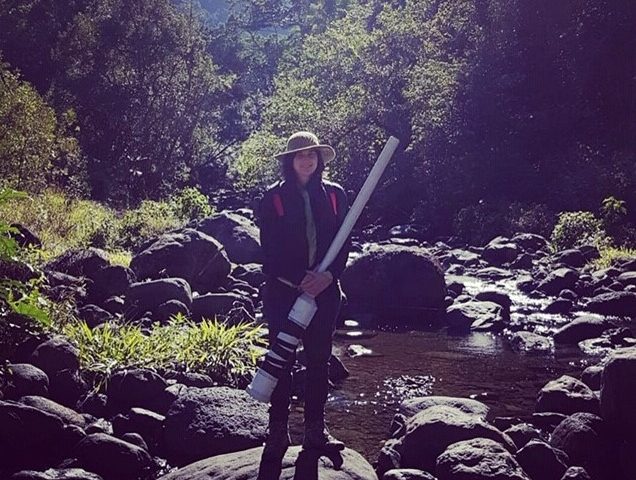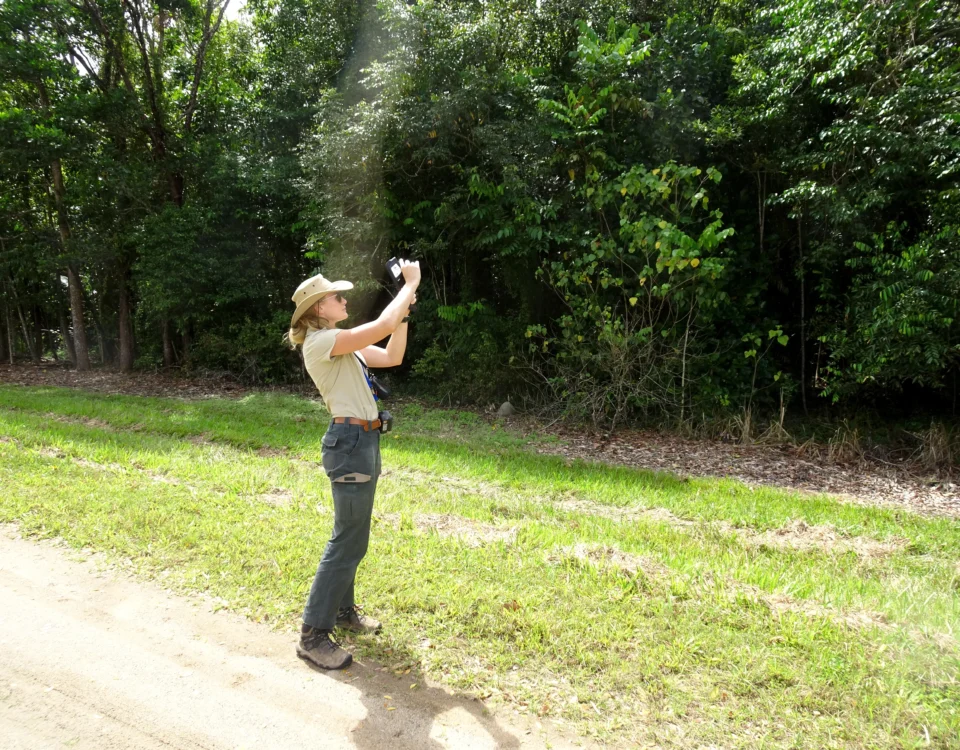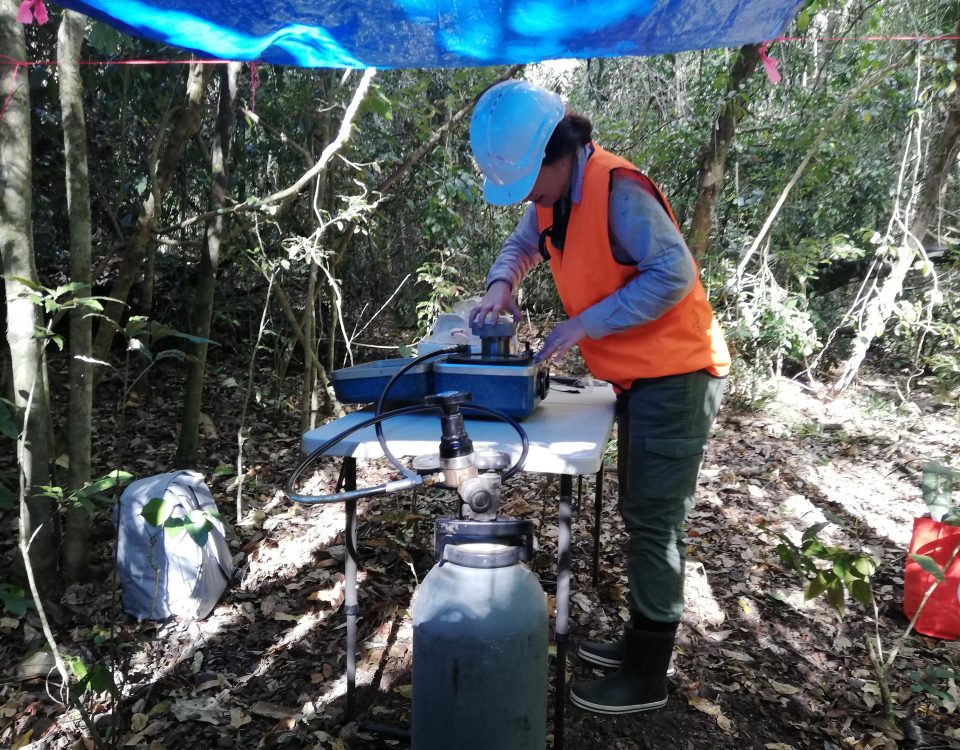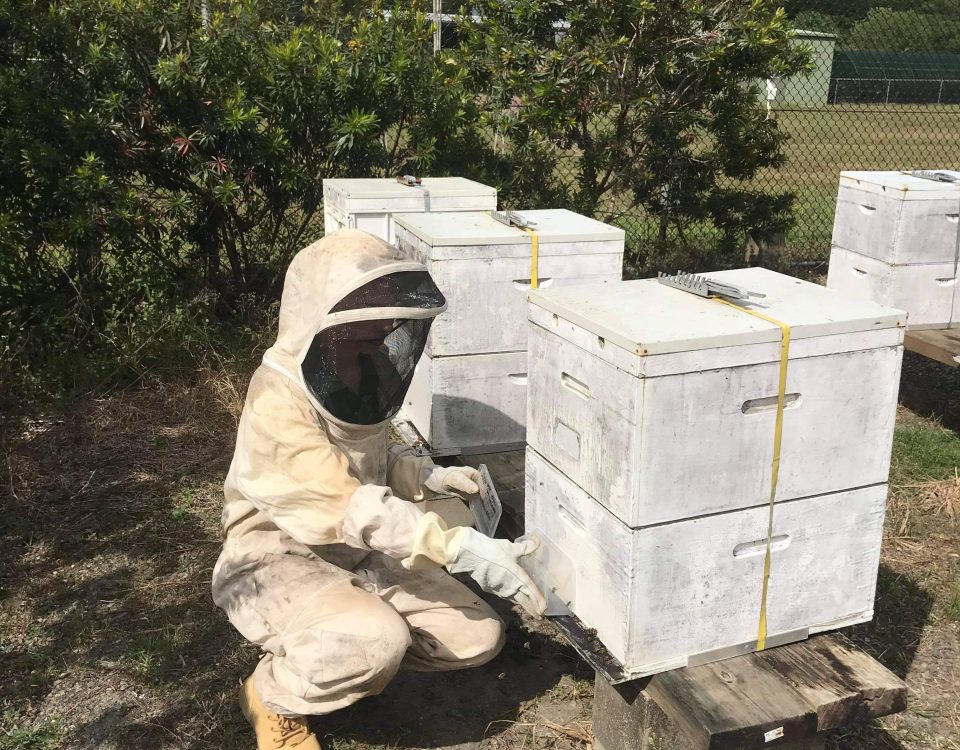Sally Cooper

Do restored subtropical rainforests capture the genetic diversity of their wild reference communities?
W ith the generous support of grants from Tweed Shire Council, Big Scrub Landcare and Skyrail Rainforest Foundation, I have been able to embark on my Masters research with Southern Cross University’s Plant Science Unit. The research question I am aiming to answer is “Do restored subtropical rainforest communities capture the genetic diversity of their remnant reference communities?”. This research question is being addressed by investigating several genetic diversity measures for microsatellite markers from three characteristic species of subtropical rainforest (white booyong Argyrodendron trifoliolatum, Watkin’s fig Ficus watkinsiana and native tamarind Diploglottis australis). The hypothesis we wish to test is that there is a reduction in genetic diversity for rainforest tree species between remnant (wild) and restored communities. Due to a number of constraints, we have had to limit the study to three species. The null hypothesis is that restoration processes have adequately sampled the genetic diversity of the remnant populations. A econdary question is, “Are trees in restored communities more inbred than those in the remnant reference communities?”.
The purpose of this communication is to provide an update to the grant providers as to the status of the research, including preliminary results. Full results and analysis will be included in the final thesis document and this chapter of the thesis is intended to be submitted for publication in the scientific literature.
Genetic diversity is defined here as the degree of variation within the genotypes of a species. This variation has been assessed at the molecular level by Investigating several neutral microsatellite markers (also known as Simple Sequence Repeats SSRs) within each target species. There are various ways of measuring genetic diversity. In this research, the focus was on allelic diversity and heterozygosity, using the measures of allelic richness (Rs), total gene diversity (He) (also known as expected heterozygosity) and observed heterozygosity (Ho). Allelic Richness (Rs) is the number of alleles per locus with a rarefaction method applied in order to account for variation in population sizes. Gene diversity (He) is the proportion of heterozygous genotypes expected under Hardy-Weinberg equilibrium (i.e. unchanging allele frequencies). Oberserved heterozygosity (Ho) is the frequency of heterozygous individuals in the studied population.
All plant specimens in both replicate regions (the Tweed caldera and the Big Scrub) have been collected.
(Total 287 samples)
Preliminary Results
In four out of six cases, the allelic richness was higher in the remnant than in the restored populations (as suggested in our hypothesis). However, in only one case was this statistically significant. In four out of six cases, the inbreeding coefficient for a restored population was higher (indicating greater inbreeding) than the remnant population. In one case, this was statistically significant. These cases supporting the hypothesis occurred across all species tested.
There is some indication of a reduction in allelic diversity in the samples collected from restored versus remnant communities with four of six comparisons having a higher allelic richness in the remnant populations compared with restored populations. The result for white booyong in the Big Scrub was statistically significant (Rs, p = 0.017). The difference in gene diversity was also significantly different there for white booyong (He, p = 0.034) with higher He in the remnant population. The difference in allelic diversity was of a similar magnitude between the Tweed remnant versus restored populations, but the difference was not significant.
In support of a secondary hypothesis that inbred individuals would be more common in restored than in remnant communities, the inbreeding coefficient was higher in restored populations in four of the six comparisons. In Watkin’s fig in the Tweed region, this was statistically significant (F, p = 0.003) and was associated with a significant difference in observed heterozygosity (Ho, p = 0.012).
Gene diversity was significantly higher in the remnant populations for white booyong in the Big Scrub (as mentioned above) and native tamarind in the Tweed (He, P=0.044)). Refer to Table 1 for summary of genetic diversity results. It is noteworthy that all statistically significant differences were in the direction hypothesised. However, non-significant differences in the opposing direction were found, for example, in the case of Watkin’s fig in the Tweed, allelic richness (Rs) and gene diversity (He) were higher in restored versus remnant samples (P=0.638 and 0.243, respectively). The results of the inbreeding coefficient (F) for this cohort was consistent with the hypothesis, it was found to be significantly higher in the restored samples (P=0.003). So, the results suggest the samples from this restored cohort are more genetically diverse but more inbred than its remnant reference population. For this same species in the Big Scrub, the allelic richness (Rs) and observed heterogyzosity (Ho) was found to be higher in the remnant versus restored samples, whilst the gene diversity (He) was found to be higher in the restored versus remnant samples, but none of the differences were statistically significant.
In general, genetic diversity amongst all samples was found to be quite high (Rs ! = 13.76, He ! = 0.86). However, inbreeding was also found to be quite high (F ! = 0.25). The exception is Watkin’s fig which shows results close to panmixia (random mating) with the exception of the restored population in the Tweed which, unlike the other Watkin’s fig populations, has evidence of quite high inbreeding (F=0.27). A review of homozygote probabilities for individual fig samples suggests selfing in several of the Tweed restored Watkin’s fig population, meaning the stock used at some of the restoration sites was a product of a mature fig self-pollinating. This will have contributed to the relatively high inbreeding result.
In outbreeding species, inbreeding is typically expected to reduce fitness, i.e., survival, by increasing the proportion of homozygous loci, which, in turn, increases the chance of deleterious recessive alleles being expressed. This is especially the case with selfed progeny, where there is a 25% chance of each deleterious allele to be homozygous (and therefore expressed). The expression of deleterious recessive alleles is greater in smaller populations that already have reduced genetic variation. Despite evidence of inbreeding, the populations studied may be sufficiently large to maintain relatively high levels of genetic diversity and minimise the chance of a loss in ecological fitness.
In summary, statistically significant results support the hypotheses of greater allelic richness and lower inbreeding in remnant versus restored populations. However, the results are not uniform, and possible reasons for this are discussed below. Of note is the similarity of the genetic diversity results for each cohort from the Tweed caldera and Big Scrub. These two sampling regions acted as replicates for the comparative analysis between remnant and restored populations. The consistent results across the regions provides added confidence to the patterns we are seeing for these species between their remant and restored populations



Some restored communities are genetically differentiated from their remnant reference communities.
Whilst the results may not consistently show significantly less genetic diversity in the restored populations, some of the restored populations were found to differ genetically from the remnant populations.
Genetic relatedness within and among populations and regions was tested with an AMOVA assessment of the fixation index – Fst (θ) - a measure of the proportion of shared alleles. The majority of the molecular variance was found to occur within individuals (88%, 69% and 52% for fig, booyong and tamarind, respectively). Molecular variance between individuals was 9%, 1% and 44% for fig, booyong and tamarind, respectively. A relatively small proportion was found between populations (3%, 1% and 4% for fig, booyong and tamarind, respectively). No molecular variance was found between regions (0% for all species), suggesting genetic connectedness, at least in the relatively recent past, due to gene flow between these two regions.
Significant genetic differentiation was detected for some of the restored populations. This was found to be particularly so in the Tweed. In the case of Watkin’s fig, the Tweed restored population was found to be genetically differentiated from all other populations, including the remnant Watkin’s figs in the Tweed (θ=0.053; P=0.001) and those from both remnant and restored communities in the Big Scrub (θ=0.051; P=0.001 and θ=0.044; P=0.001, respectively). In the case of white booyong, the individuals collected from the Tweed restored communities were found to be significantly genetically differentiated from the remnant white booyongs in the Tweed (θ=0.021; P=0.001) and the restored white booyongs in the Big Scrub (θ=0.030; P=0.001), but not significantly so from the remnants in the Big Scrub (θ=0.007; P=0.091). In the case of native tamarind, the Tweed restored population was found to be significantly genetically differentiated from the remnant population in the Tweed (θ=0.055; P=0.001) and both Big Scrub remnant (θ=0.062; P=0.001) and restored (θ=0.067; P=0.001-) populations. The restored native tamarind community in the Big Scrub was also found to be significantly differentiated from the remnant populations in this region (θ=0.027; P=0.001) as well as the Tweed remnant population (θ=0.021; P=0.001). However, in the case of native tamarind, as previously discussed, the data is based on only three loci and should be interpreted with caution. Refer to Tables 2-4 for genetic relatedness results.
So, whilst in some cases the restored communities appear to contain comparable genetic diversity to remnant populations, they are not always genetically reflective of their remnant reference communities. This is particularly so for the Tweed region. This is likely influenced by the variability in how different restored communities are created (e.g., where and how seed/stock is sourced, whether the site had supplementary planting over time, etc.). It also reinforces the importance of genetic considerations in community restoration planning and suggests restored communities are not necessarily capturing remnant communities at the genetic level. Relying on restored communities to replace loss of remnant communities could potentially result in a loss and/or change of alleles represented locally. There is some evidence that inbred individuals are being deployed and these individuals may have resulting lower fitness than remnant individuals.



